I’m just going to say it… most B2B SaaS companies have a broken lead capture funnel.
This picture feels like the most relevant way to convey how I feel…
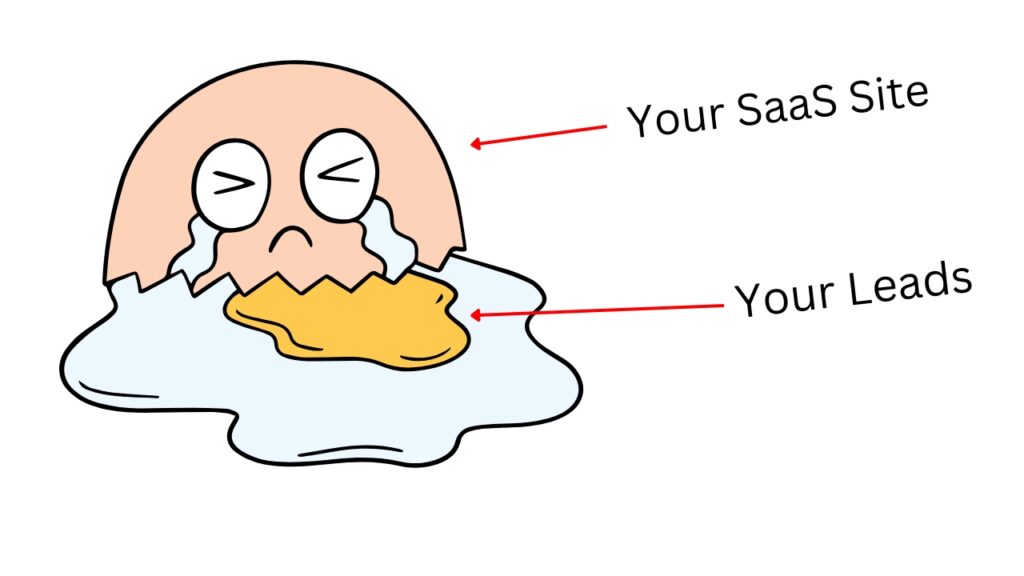
The broken egg represents the average SaaS site.
The yolk represents the lost leads and conversion opportunities that are are leaking out…
Here’s the thing… after over a decade on the marketing side of SaaS, I’ve noticed a recurring issue across almost every SaaS website I look at.
The culprit?
It’s not a lack of top-of-funnel efforts. It’s something you might not expect…
It’s a lack of optimization in the critical middle-funnel stage, where website visitors should convert and get qualified but often slip through the cracks instead.
I call this the “SaaS Lead Capture Funnel,” and for the vast majority of SaaS companies out there, this funnel is seriously broken.
This problem, presents a huge opportunity for both higher conversion rates and reduced CPLs. Let’s break it all down in this post.
Short on time? Watch this quick video where I walk you through how I fixed ours over at LeadCapture.io
The Problem: The SaaS Lead Capture Funnel is Broken
Take a good hard look at your SaaS site.
What’s the lead capture process like?
Is it just a giant button on your pricing page that says, “Request a Demo,” leading to a generic form?
Or, are you using a static form on your demo or pricing page, built from Salesforce, HubSpot, or your landing page builder?
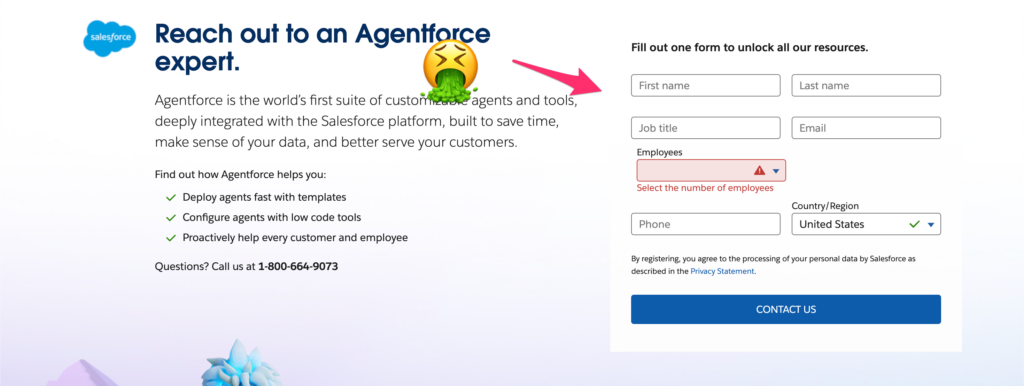
Here’s a better approach:

If what I described sounds familiar, don’t worry – you’re not alone. This is one of the biggest issues across most SaaS websites. Most SaaS GTM teams focus on optimizing the top of the funnel (getting people to the site) but give far less attention to the middle and bottom of the funnel, where visitors go from being just another anonymous click to becoming a lead.
And it makes sense in theory: if you add more to the top of the funnel and keep the conversion rate steady (which rarely happens), you’ll see more come out at the bottom.
But what usually happens is that as you spend more on top-of-funnel activities, your entire funnel becomes less efficient if the middle and bottom stages aren’t optimized. As a result, CPLs balloon, CAC goes up, and you end up paying 2-3x more for leads.
I’ve seen it time and again: SaaS marketing and sales teams driving traffic into an unoptimized, broken middle-funnel where traffic leaks out.
And here’s another key point, especially for B2B sales-led SaaS orgs selling enterprise solutions with longer sales cycles.
The SaaS Buyer Journey Is Not Linear
We often think that if someone clicks through from a Google ad to a SaaS landing page, they’ll convert right away.
But in reality, they’ll likely come back multiple times, checking out various pieces of content and even using different devices.
Is your SaaS website optimized to engage and capture these prospects throughout their journey? For most, this is a huge missed opportunity.
The Opportunity in Fixing the Broken SaaS Lead Capture Funnel
Now imagine if you optimized your lead capture systems in the middle of the funnel to make it more engaging (I’ll discuss how to do this shortly). You’ll see three huge benefits right away:
- Increased Conversions from Existing Traffic: Visitors from sources like direct, referral, social, organic, and even those who drop off from paid ads will start converting into demos organically. This means more demos constantly pumping out of your website.
- Higher Conversion Rates Across Top-of-Funnel Investments: By making the middle of the funnel more efficient, your performance marketing channels will start yielding better results.
- Lower Blended CPLs and CAC: As conversions improve, your blended CPLs and CAC will decrease, giving you more marketing dollars to reinvest in growth.
By focusing on optimizing the middle of the funnel — where conversions start happening — you make your entire marketing strategy more efficient and effective.
How to Fix a Broken SaaS Lead Capture Funnel
So, what’s the solution? It starts with a highly optimized SaaS lead capture funnel.
A lead capture funnel isn’t some complex, over-engineered piece of software. It’s a simple, interactive lead capture widget you add across high-intent pages to guide prospects through the conversion process, gathering information and micro-qualifying them as they go.
Instead of throwing a generic form at them and hoping for the best, you lead with a question or two that’s easy to engage with. As your prospects answer, you ask progressively more qualifying questions, collecting all the data you need to serve them better before posting the lead to your CRM and routing it to sales.
Example: Gong’s Pricing Page Lead Capture Funnel
Gong’s pricing page is a great example of an optimized lead capture funnel.
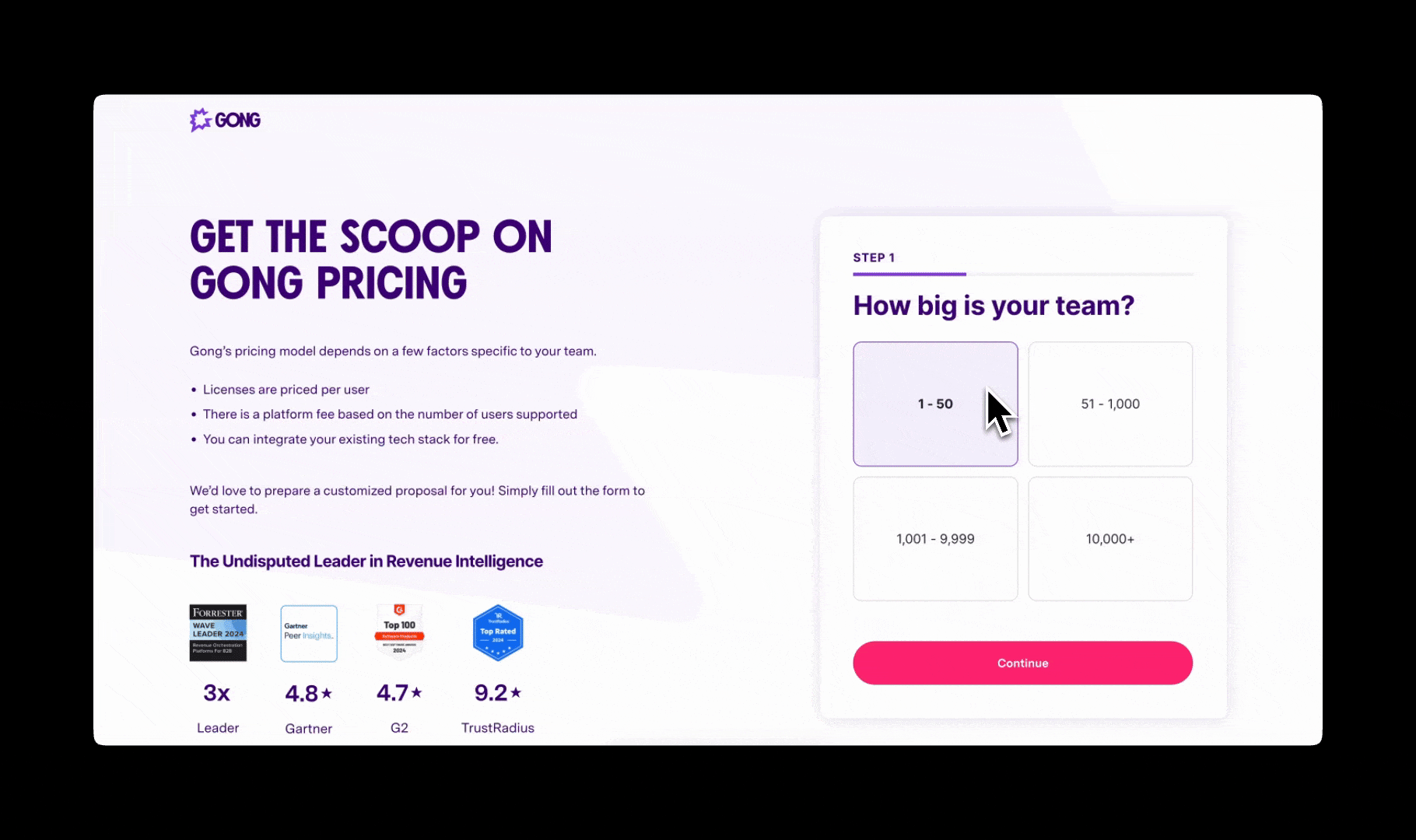
Instead of using a static Salesforce or HubSpot form, Gong engages prospects with an interactive funnel that asks one simple question at a time. This reduces friction and keeps prospects engaged.
They start with an easy question, like, “See Gong in action?” As prospects move through, they answer more qualifying questions without feeling overwhelmed. It feels like a conversation, not a huge commitment, which is the key to keeping them engaged.
Now, Gong is only scratching the surface here. Let’s take things to the next level in the section below.
Case Study: How I Drive Qualified SaaS Demos at LeadCapture.io With Three Lead Capture Funnels
Now let me show you how I’ve applied this strategy to my own SaaS website, LeadCapture.io, to boost qualified inbound demo requests.
At a high level, I’ve optimized my SaaS website’s lead capture process with three funnels across the following areas:
- High intent area #1: Pricing page
- High intent area #2: Demo page
- Key pages: home page, feature pages, about, blog posts
Let’s drill into each:
On my pricing page, I’ve embedded a high-converting lead capture funnel. It doesn’t start with “Request a Demo” or “Schedule a Call.” Instead, it begins with a simple question: “How many leads are you capturing per month?”
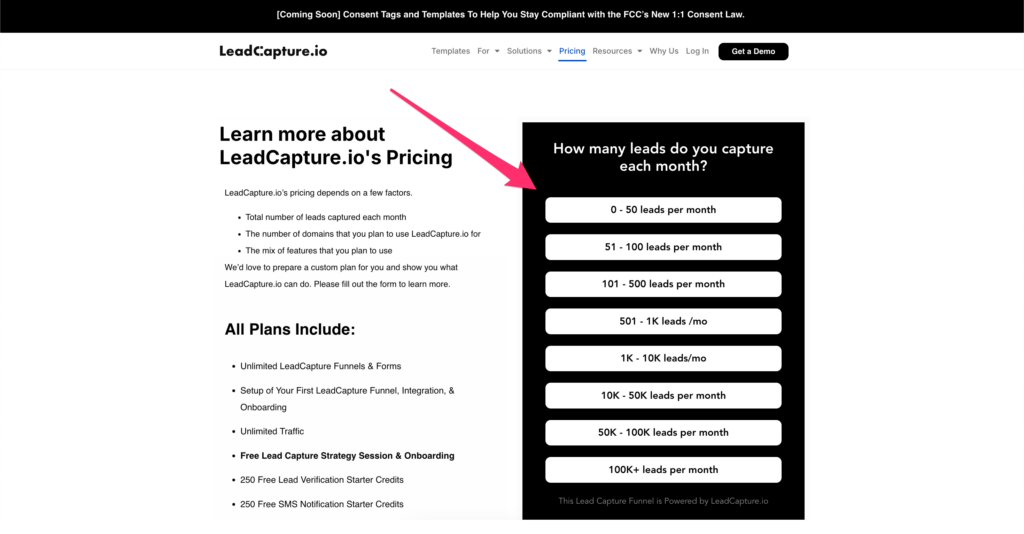
Why? Because I’m making it easy for prospects to engage with micro-commitments.
This approach leverages the foot-in-the-door technique, where small initial requests increase compliance with larger requests. As they answer, I progressively qualify them with questions tied directly to my sales demo process.
In my case, I even use phone verification to ensure I’m getting high-quality leads. This might sound like overkill, but I’ve achieved a 90+% show rate on demos just by making small tweaks and verifying phone numbers.
Optimizing My SaaS Demo Funnel for a 17% Conversion Rate
On my demo page, the lead capture funnel converts at 17%, while my pricing page funnel gets about 6% – not bad!
The difference? On the demo page, I start by asking for their contact info, followed by qualification questions.
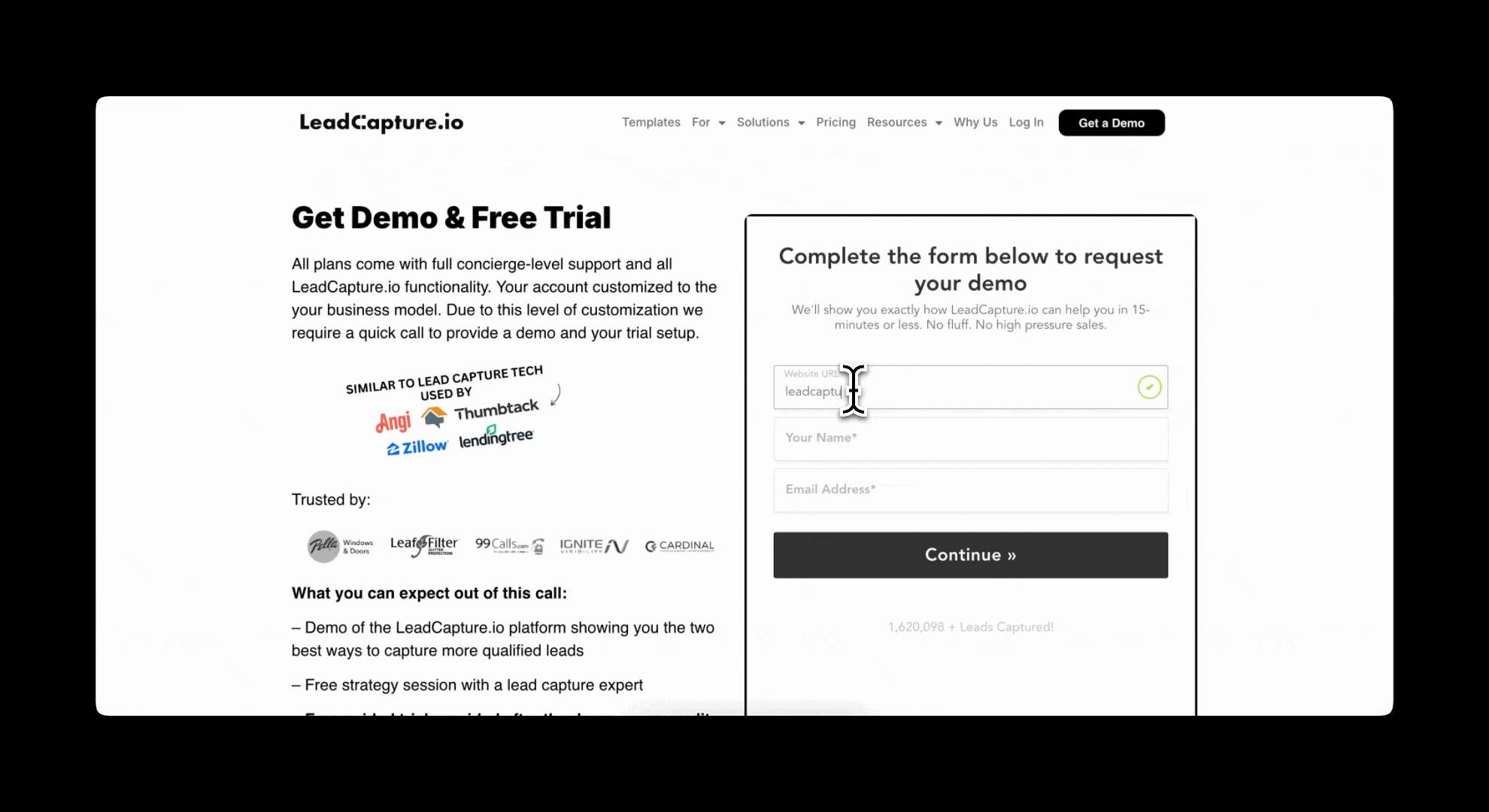
Why lead with contact info first on this one, but not on the pricing page?
- High-Intent Visitors: Anyone on the demo page probably has high intent, so I collect their details upfront.
- Testing: I’m constantly testing different approaches.
- Drop-Off Mode: If someone starts filling out the funnel but doesn’t complete it, I still capture their details as a partial submission, allowing me to follow up. This is a feature that’s exclusive to LeadCapture.io.
Expanding Lead Capture Funnels Across the Website
I’m not stopping with just the pricing and demo pages. I’m experimenting with ways to capture leads across the entire LeadCapture.io site.
For instance, I offer a free strategy call, which pops up on key pages, like my home page.
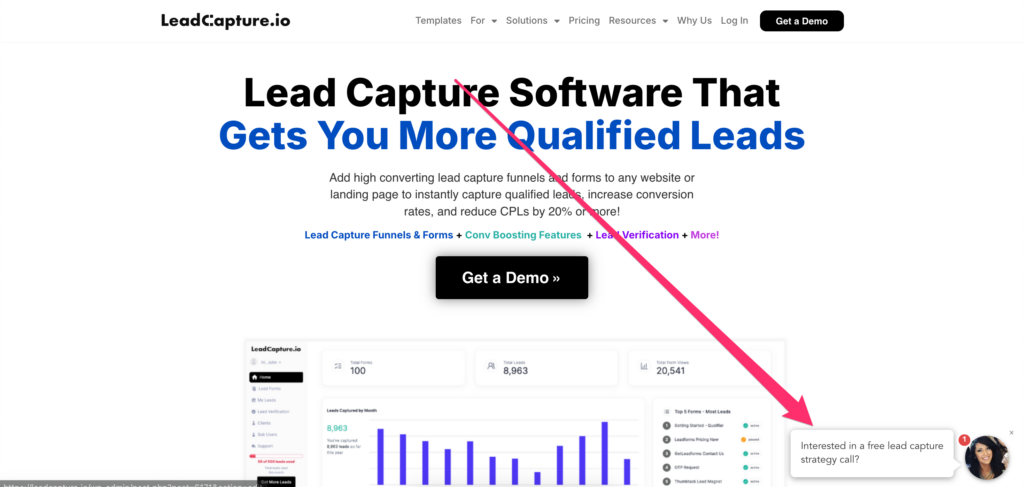
And blog posts:

It’s a friendly, non-intrusive funnel that shows up at the right moment — like when someone is about to leave the site or has been browsing for a while.

This funnel qualifies prospects without feeling pushy or gimmicky, keeping them engaged as they browse.
Final Thoughts — This is One of Your Biggest Opportunities for More SaaS Demos & Lower CPLs
As you can see, I’ve turned LeadCapture.io into a high-functioning SaaS demo conversion machine.
I know that when I send traffic to LeadCapture.io, highly qualified demos will flow into my pipeline.
Isn’t that what we all want in SaaS?
The SaaS buyer’s journey is messy. Visitors don’t follow a neat, linear path from one page to the next. They jump between devices, pages, and content pieces. That’s why you need lead capture funnels in more places than just your demo or pricing page. They should be everywhere on your site — blog posts, landing pages, feature pages — all ready to engage and qualify.
And you should constantly test different offers, hooks, and ways to drive qualified prospects into your funnel. This approach can take you from a 1% conversion rate to 6%, 17%, or even 30%+ across your site.
If you’re reading this and thinking, “I’d love to try this,” click this link to book a demo with me. I’ll give you a tour of LeadCapture.io and help you set up these funnels across your SaaS website to drive more qualified demos and decrease CPLs.

